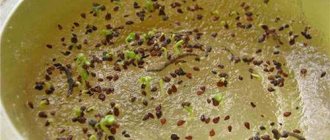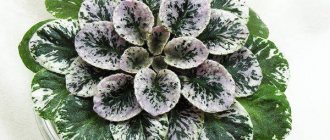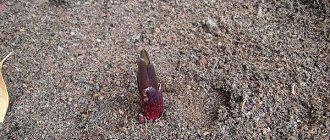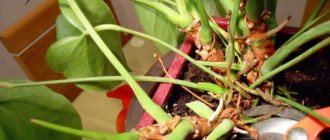Violet is a heat-loving plant, many are familiar with it, but everyone knows that the birthplace of the flower is sunny and hot Africa, and it was first found in the Uzambara Mountains.
The question of how to care for violets in winter is very important; the plant should not be exposed to cold, otherwise you may lose this beautiful flower. Let's talk about how to provide Saintpaulia with the right environment and care during the cold season so that the plant feels comfortable and can safely overwinter.
Differences in winter care
Caring for Saintpaulias in winter in our not too mild climate is not easy because these flowers are very heat-loving plants, but do not tolerate direct sunlight, and our winters do not indulge in an abundance of warm, cloudy days. It often happens that violets in winter take on a sluggish and withered appearance, so it is advisable to give Saintpaulia a place on the windowsill with a view to the north or west, or to cover the flower with curtains. The health of the Saintpaulia variety Winter Cherry is well illustrated by its leaves.
If the violet leaves have a fresh green color and are located symmetrically, then everything is in order with the plant and you are caring for it correctly.
If part of the flower has turned yellow, you should turn its “sick” side towards the sun. To properly care for these flowers at home during the cold period, you need to ensure that the diameter of the container where they grow does not exceed fifteen centimeters. The soil in the pot with Saintpaulia should be loose without lumps. It is better to mix ordinary soil for caring for Winter Cherry flowers at home with expanded clay in equal proportions. In order for Saintpaulias to feel comfortable at home, the soil on which they grow should be constantly moistened, but make sure that the root system of the plant does not rot.
Transplanting violets at home: choosing a flower pot
Preparation for transplanting violets begins with selecting a new flower pot. Very young plants can be planted in plastic cups; as the violet grows, the size of the container gradually increases. The diameter of the pot for an adult plant should not exceed 13-15 cm (the height is about 10-12 cm).
The pot can be either plastic or clay; there are no clear recommendations here, and this issue is decided at your discretion. However, do not forget that clay is a breathable, eco-friendly material that can absorb excess moisture.
If you practice “wick” watering, then before replanting, insert soft cords or strips of fabric into the drainage hole, which will act as a wick and deliver moisture to the roots of the plant. You can fix the wick using expanded clay or small pebbles, which will serve as a drainage layer.
Temperature
As already mentioned, violets love warmth very much, and the temperature to which they are accustomed is 20-25°C, which should be maintained when caring for Saintpaulias at home. Because of this, flowers are difficult to care for. As a last resort, you can allow it to drop briefly to 12°C at night. Prolonged cold can lead to burns of leaves and shedding of inflorescences.
When caring for Winter Cherry Saintpaulias at home, you should not allow the flowers to be exposed to excessively high temperatures, for example, the proximity of heaters, split systems, and radiators of the heating system. Metal stands and decorative lighting have a negative impact on violets of the Winter Cherry variety in autumn and winter. The presence of both leads to the evaporation of water from the surface of the flower and the violet leaves turn yellow.
Cold in a room with Saintpaulias leads to the formation of rot on the leaves of the plant, and heat leads to the occurrence of diseases and parasitic organisms. If your desire is to have beautiful flowers of this type, you need to take proper care of them. When a constantly hot climate is maintained in the room where they are located, you need to be prepared that the Saintpaulia inflorescences in this case will not be so bright and smaller in size.
To obtain large and eye-pleasing flowers, you need to give the violets a seasonal respite for several days, slightly lowering the temperature in the room with them.
Safety net for sissies
Experienced gardeners, to be on the safe side, always preserve their favorite varieties by placing several leaves in water for rooting. This will help not to lose a specific type of crop in the event of its death.
In addition, Saintpaulia needs to be updated periodically. Rooted cuttings will come in handy - in a couple of years they will become a full-fledged replacement for old bushes.
- Author: Zimina Tatyana
Rate this article:
- 5
- 4
- 3
- 2
- 1
(4 votes, average: 4 out of 5)
Share with your friends!
Watering
In the cold season, any flowers, including the species described, require less moisture.
Watering Saintpaulias in cold weather is, in principle, no different from feeding most house flowers with water. However, it should be borne in mind that excess water can lead to rotting of the rhizomes of violets of the Winter Cherry variety, so watering them in bad weather should be done when the soil in the flower pot becomes completely dry, but under no circumstances should you overwater the flowers.
In general, to saturate the Saintpaulia Winter Cherry with moisture, it will be enough to wrap the pots with them in a warm, damp cloth, as publications for gardeners recommend caring for them
Preparing soil for violets
In almost any flower shop or garden center you can purchase ready-made soil for violets (or Saintpaulias). If you are used to preparing the soil mixture yourself, then you will need to mix peat soil, coarse sand and black soil in a ratio of 3:1:5. Also, some kind of baking powder must be added to the mixture, which will improve the moisture permeability of the soil (crushed expanded clay, sphagnum or vermiculite). The volume of such an additive must correspond to the volume of sand.
Regardless of whether you bought the soil or prepared it yourself, the soil must be disinfected before replanting the plant. To do this, spill the soil with a weak solution of potassium permanganate, steam it or bake it in the oven. Considering that such treatment can destroy not only harmful, but also beneficial microorganisms, vermicompost (a small amount) can be added to the ground before planting.
When planting, the soil should not be dry or waterlogged, it should be moderately moist, light and free-flowing.
What else can threaten violets?
These delicate sensitive flowers react to any changes in their conditions. Caring for violets in winter is difficult because it is not only a decrease in temperature, daylight hours and abundant watering that is harmful to them. A normal change in location or absence of people that these plants are used to can cause them to become sick. For prevention, it is recommended to treat flowers with Epina twice a winter. Topaz solution helps against some diseases. In serious cases, the plant can only be saved by complete replanting and removal of diseased parts. To prevent flowers from suffering from excess carbon dioxide, which often happens in winter, you need to ventilate the room more often, however, protecting the plants from drafts.
If you know how to care for violets in winter, you can easily provide these sensitive plants with the conditions they need. And then they will delight you with their beautiful delicate flowers all year round.
Transplanting violets
It is recommended to do this in autumn or spring. But if the plant has stopped flowering, then you need to replant it and arrange a dormant period for a couple of months. Many gardeners are interested in whether it is possible to replant violets in winter? Replanting is needed if you have flooded the plant and the roots have begun to rot, or for plants infected with any parasites. This should not be done if the room is very cold. Instead of expanded clay, it is better to add pieces of foam plastic to the pot where you plant the plant; they will better protect the violet from hypothermia in winter. It is recommended to water the transplanted plant with just a little warm water and cover it with a bag. This will protect it from drafts.
Popular fertilizers
Fertilizers for violets are produced in the form of mixtures for root application or spraying of leaves. In the first case, they are added to water for irrigation, in the second, they are poured into a spray bottle and used according to the instructions. Foliar sprays are useful for young plants with weak root systems. This way they will be able to receive all the nutrients and use them for their further development.
Bona Forte
This is a liquid fertilizer that contains both organic and mineral components. It can be purchased in specialized stores. The solution is in small green bottles of 285 ml. The composition of this supplement is represented by the following substances:
- the main complex of minerals (nitrogen, phosphorus, potassium);
- additional microelements in the form of chelates - this way they are better absorbed by the plant;
- humic acids - organic compounds that increase the chemical characteristics of the soil and retain minerals in the soil.
Fertilizer can be either applied to the soil or used to spray leaves. 10 ml of concentrate is diluted in 1.5 liters of water and watered the plant until the earthen clod is completely moistened. For spraying, it is worth preparing a less concentrated solution - half the amount of substance is enough.
Good power
Liquid complex fertilizer produced in Russia. It has a similar composition, but succinic acid is added here. This element is considered to stimulate the growth and flowering of indoor plants, and also increases their resistance to adverse environmental factors.
From March to October, fertilizing is applied once a week, the rest of the time - once a month. The mixture is sold in a small bottle with a dispenser cap. The contents of one cap (5 ml) are added to 500 ml of clean water for irrigation. The consumption of the product depends on the size of the pot; after applying the fertilizer, the soil should be completely moistened.
Flower heaven
The mixture “for violets and primroses” from the Buyskie Fertilizers company has proven itself well among both amateurs and experienced gardeners. Its composition is represented by the main minerals for growth and flowering. The drug is sold in any flower shop in a yellow 200 ml bottle. Also included is a 20 m measuring cup (cap), which is useful for preparing the working solution.
There are divisions on the cup. It is necessary to measure 10 ml of concentrate and combine it with 1 liter of water. This mixture can be used to water plants or spray leaves. Root feeding is carried out once a week during the growing season, and in the cold season - once a month. It is recommended to apply the solution using the foliar method no more than once a month.
Fusco
Fertilizer from the “Flower Happiness” series. It contains the standard combination of nitrogen, potassium and phosphorus, as well as additional microelements in lower concentrations. The bottle contains 250 ml of concentrated liquid. It is measured with a special cap - its contents (10 ml) are enough for 1 liter of water. According to the instructions, during the flowering phase, fertilizer is applied once every 10-14 days; the rest of the time, once a month is enough.
REASIL
REASIL fertilizer “for violets” is distinguished by its composition. In addition to the standard set of microelements, it contains a significant portion of organic substances:
- amino acids are natural growth stimulants;
- hydroxycarbolic acids (gluconic, lactic, succinic and others) - improve the absorption of minerals;
- humic compounds - participate in the processes of photosynthesis and energy exchange;
- vitamins of groups B and C.
The fertilizer can be purchased in a green bottle (250 ml) with a yellow dispenser cap. The working solution is prepared at the rate of 5 ml per 5 liters of water for irrigation, and for spraying its concentration should be half that. Root feeding can be carried out no more than once a week, spraying - no more than once a month.
Preparations for abundant flowering
Before the beginning of the flowering period, Saintpaulias need an additional preparation that contains phosphorus in large quantities. We already wrote above that it is this microelement that is responsible for the high-quality budding of the plant. The application of such fertilizing is combined with the removal of stepchildren. It will be just great if you add artificial illumination of the flowers to these actions.
And when the buds are formed, and you understand that this stage has been successfully overcome, the time will come to introduce fundamentally different compounds - those that can make violets bloom abundantly and lushly. Boron and potassium predominate in such fertilizers. Their choice is great. We will list several main names and groups so that, if necessary, you can freely navigate the ocean of market offers.
- “Uniflor” series. Products produced under this brand are used for both spraying and watering. For example, the drug “Uniflor-micro” is diluted in one liter of water in the amount of 1 ml of the drug if the grower intends to use the resulting liquid for irrigation. If he intends to spray the nutrient composition onto the plant, the concentration stated above must be reduced by 50%.
- Alliance concentrate. This is a complex preparation that consists of 8% nitrogen, 10% phosphorus and a similar percentage of potassium. It has a positive effect not only on the immunity of Saintpaulia, but also directly affects the flowering process, stimulating the formation of multiple flowers.
- Preparations TM Forte “Health”. These products contain half a percent of humic acids and almost 20% of the basic microelements necessary for Saintpaulias. The products are universal for violets and begonias. They help plants breathe properly. If you use such compositions for foliar feeding, then one bottle will be enough for you to prepare more than 40 liters of fertilizer.
- Fertilizers “BioMaster”. Another series of complex drugs produced in powder form. The powder is packaged in portioned sachets, each of which contains 25 grams of nutritional mixture. It should be diluted in half a liter of water before using for its intended purpose. In addition to the fact that BioMaster fertilizers stimulate flowering and increase the protective abilities of violets, reducing the risk of developing serious ailments, they are also one of the best ways to prevent chlorosis. To obtain a solution for watering or spraying, you need to dilute 5 ml of the substance from the bottle in a half-liter jar of water.
As you can see, the process of fertilizing Saintpaulia is a whole science.
It is important not only to know the names of suitable drugs, but also to be able to use them correctly and in a timely manner.
What water is suitable for indoor Saintpaulias?
When watering, you must remember that you cannot use tap water .
It contains a high content of chlorine, which is harmful to the plant. The best method is to use the following:
- The water sits for a day or two in the light in an open container. It is necessary to stir periodically. In this case, the chlorine evaporates.
- The settled liquid is boiled to kill bacteria for 1 minute.
- After boiling, the water must be acidified. Add a teaspoon of acetic acid or 5 granules of citric acid to one liter of water.
- Violets love warm water, best if it is at room temperature.
Has your Saintpaulia not bloomed for a long time? Most likely she doesn't have enough nutrition. What fertilizers to use in this case, read the material at the link.
Step-by-step transplantation of violets
So, you have prepared a flower pot, warm settled water, soil and are ready to transplant the violet. Necessary steps:
- Pass the wick into the hole at the bottom of the flower pot and place a drainage layer on the bottom.
- Pour soil, place the plant in the pot and straighten the roots, gradually adding soil. Using a small spatula or stick, the soil should be slightly compacted.
- The soil should be added until you reach the level of the root collar, then carefully water the plant using a syringe; the soil will settle a little during the watering process; it should be filled up to the previous level (without deepening the root collar).
- Very carefully, so as not to damage the leaves, rock the violet from side to side to make sure it sits firmly in the ground. Vermiculite can be sprinkled onto the soil surface to act as mulch.
- In order for the violet to adapt as quickly as possible, you can build a shelter from a bag that will help maintain the desired air temperature and prevent moisture evaporation. It is only important to ensure ventilation, since violets do not tolerate high air humidity very well.
Transplanting indoor violets. Preparation for the process
If you are planning a transplant during the day, then water the plant in the morning - this will make it easier for it to slip out of the pot; pre-watering reduces the risk of mechanical damage.
Carefully inspect the root system, carefully clearing it of soil if possible.
If you find damaged roots with traces of rot, they should be removed and the sections sprinkled with crushed charcoal or activated carbon.
If all the roots are healthy, but have grown very much, then at least half can be cut off without damaging the plant (the cuts can also be treated with charcoal). In both cases, it is important to use very sharp and pre-disinfected scissors.
If rot has affected the entire root system, then after removing the affected part, the flower can be rooted in water by dissolving an activated carbon tablet in it, and after the roots appear, planted in the soil according to all the rules.
Pests and diseases
Plants, like all living organisms, can be affected by pathogens and become targets for parasites. You can reduce the likelihood of illness by following the rules:
It is important not to place purchased flowers next to the entire collection of violets for a month; for preventive purposes, the buds should be removed; To avoid death, plants should be accustomed to a change in climate from wet to dry; When handling a diseased plant, thoroughly clean your hands.
The most common diseases of violets are rot and yellow leaf spot. Rotting is a consequence of excessive watering, root diseases or pest damage. The penetration of microorganisms that cause rot occurs. In this case, it is necessary to cut off the lower part of the violet along with the root. When there is strong light or moisture on the foliage, spotting occurs. Fungi, viruses or bacteria are the causes of violet diseases.
If the plant is lethargic for a long time, it can be assumed that it is affected by late blight. It is urgent to cut off the top and lower the roots into water. A common fungal disease is fusarium. At the beginning of this disease, the roots rot, then the stem and leaves are affected and the plant becomes unviable. You need to destroy the plant and treat the pots.
There are a lot of pests that attack violets. The main enemy of violets is the nematode. Damaging the roots, it sucks out all the juices from the plant cells. It is not possible to visually identify a nematode, since these are worms that can only be seen through a microscope. When the roots swell, it is better to throw away the flower along with the soil.
If the leaves become brittle, the plant withers and stops growing, it is most likely affected by mites. To destroy these parasites, “Fitoferm” is used.
The terrible enemy of violets is thrips. It reproduces by eggs and is able to quickly produce offspring. The main manifestation of this parasite is the appearance of whitish stripes on the buds. To stop these pests from multiplying, it is necessary to tear off all flower stalks and spray the plant with a special chemical solution.
Any gardener has encountered small flies (sciarids). These parasites appear when there is abundant watering. In small quantities they do not cause serious harm. Such gnats feed on rotting remains. When abundantly reproduced, sciarids feed on plant tissues. To destroy these parasites, it is necessary to spray the soil with the preparation and dry it.











